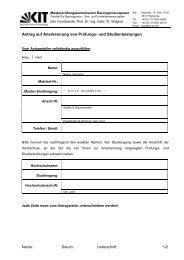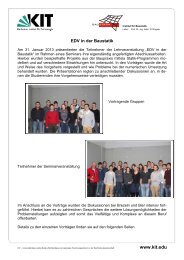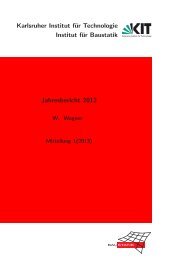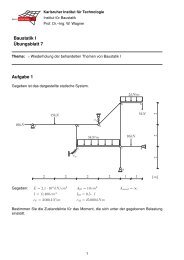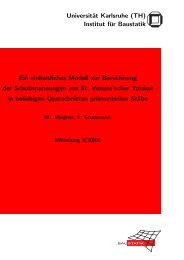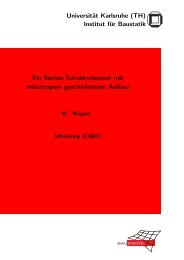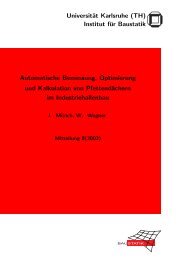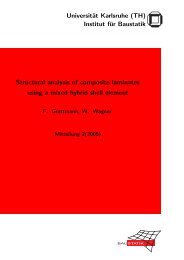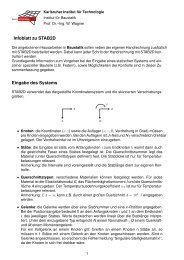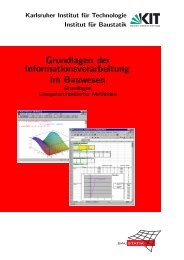Universität Karlsruhe (TH) - am Institut für Baustatik
Universität Karlsruhe (TH) - am Institut für Baustatik
Universität Karlsruhe (TH) - am Institut für Baustatik
Create successful ePaper yourself
Turn your PDF publications into a flip-book with our unique Google optimized e-Paper software.
Load P [N]<br />
3,5<br />
3,0<br />
2,5<br />
2,0<br />
1,5<br />
1,0<br />
0,5<br />
Imperfect: P/1000<br />
Perfect<br />
Imperfect, large steps<br />
0,0<br />
0 10 20 30 40 50 60<br />
Displacement u 3 [mm]<br />
Iterat. EAS-shell [17] present<br />
1 9.3256220E+04 1.0269311E+05<br />
2 2.8840619E+03 1.8419593E+03<br />
3 1.8272735E+03 9.2095431E+02<br />
4 9.8608350E+01 3.1491938E-01<br />
5 1.4371684E+02 7.2982781E-02<br />
6 1.9857848E+01 3.6491332E-02<br />
7 5.2637887E+01 7.7310783E-07<br />
8 1.4549719E+01 4.3099687E-09<br />
9 5.5153927E+01<br />
10 1.9751270E+00<br />
11 6.6634091E+01<br />
12 4.6571811E-02<br />
13 2.5106273E+00<br />
14 3.7558851E-05<br />
15 3.7154558E-06<br />
16 5.8605419E-09<br />
Figure 8: Load deflection diagr<strong>am</strong> and iteration behaviour of residuum<br />
4.5 Channel–section be<strong>am</strong><br />
A channel–section be<strong>am</strong> cl<strong>am</strong>ped at one end and subjected to a tip force at the free end is<br />
investigated next, see Fig. 9. In a first calculation we assume linear elastic behaviour and<br />
in a second step the elasto–plastic material model accoording to appendix E with constants<br />
accordingtoFig. 9. The developed shell model is compared with an EAS–shell model, [17].<br />
The discretization is performed with 360 four–noded shell elements. The shell discretization<br />
consists of 36 elements along the length direction, 6 elements along the web and 2 elements<br />
for each flange. In the elastic case we apply load control whereas for the elasto–plastic case an<br />
arc–length scheme with displacement control is used. We calculate the structural behaviour<br />
up to a tip displacement of w = 250 cm and then unload the structure. The results for both<br />
models agree very good in the total range of the computed load deflection curves, see Figs.<br />
10–11. This holds for elastic as well as for inelastic material behaviour. Fig. 12 shows a plot<br />
of the von Mises stresses for the ultimate state and the unloaded state. Similar results can<br />
be achieved using an elasto–plastic be<strong>am</strong> model, see [30]<br />
P<br />
L<br />
h<br />
P L = 900 cm<br />
h = 30 cm<br />
b = 10 cm<br />
s = 1.0 cm<br />
t = 1.6 cm<br />
E = 21000 kN/cm 2<br />
s<br />
ν = 0.3<br />
y 0 = 36 kN/cm 2<br />
b<br />
K = 0<br />
t<br />
Figure 9: Channel–section be<strong>am</strong> with geometrical and material data<br />
The robustness of the iteration behaviour is decribed in the following. Large steps are possible<br />
for the present element for elastic as well as elasto–plastic material behaviour, see e.g. Figs.<br />
19




